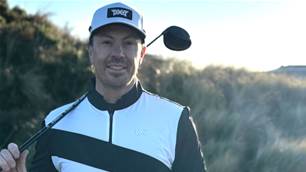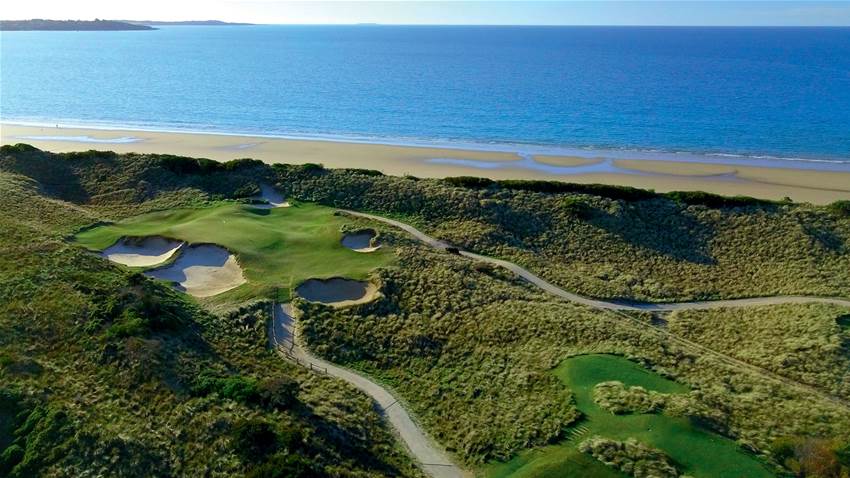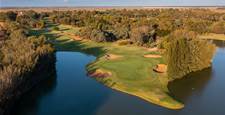Over the course of two decades, the Apple Isle has emerged as a world-class golf holiday destination, with the quality of its courses matched by the incredible food, cool climate wines, award-winning whiskies and natural attractions.
Armchair architects will also be able to submit their 18-hole creations for a future redesign at Claremont Golf Club, about 20 minutes’ drive north-west of the Hobart CBD.
A residential development has seen the redesign of the 17th and 18th holes in recent times and there are plans to eventually rework the entire routing across the small parcel of land, to take greater advantage of the riverside location in terms of views and providing memorable golf shots.
Claremont lies on a peninsula and is surrounded on three sides by the Derwent River and offers wonderful views across the water to Mt Wellington.

The river comes into play for the first time at the 174-metre par-3 2nd. It is a demanding hole that is further complicated by a small river inlet that cuts across the hole between tee and green. The target is small and, when the wind blows off the Derwent from the right, the green can be almost impossible to hit.
If you have a problem keeping your shots on the straight and narrow and sliced drives are common-place, be cautious when playing Claremont’s toughest hole – the 410-metre par-4 5th. The glistening waters of the Derwent are never far from the right edge of the doglegging fairway as it turns markedly from left to right and finishes at a smallish green guarded by a lone bunker.
Every golfer visiting Hobart should also include Kingston Beach Golf Club in their itinerary because it offers a wonderful mix of an enjoyable round of golf while treading in the footsteps of Tasmania golfing royalty.
Kingston Beach, about 15 minutes’ drive south of the CBD, has an old world charm about it and you can sense that history as you walk into the heritage-listed stone and wood clubhouse. It is here where the honour boards reveal the influence of two great Tasmanian golfing dynasties – the Nettlefolds and Toogoods.
Robert Nettlefold founded the club in the 1920s and the club’s popularity took off because of its picture postcard location beside the snaking Browns River. Nettlefold not only produced a very good golf course but his son, Len, became one of the best left-handers in the game before World War II. He remains the only ‘leftie’ to have won the Australian Amateur twice, firstly in 1926 and then 1928, while he was a member at Kingston Beach.
The Kingston Beach club professional in the 1930s was Alf Toogood, whose father finished fourth behind J.H Taylor in the 1894 Open Championship at Royal St Georges. Toogood’s two sons, Peter and John, grew up on the Kingston Beach course and continued the family love affair with the game of golf.

Peter Toogood won dozens of titles over an elite amateur career that spanned more than 30 years. He won club championships at a number of Tasmanian courses. He also won an Australian Amateur (beating his brother John in the final), was the leading amateur in the 1954 Open Championship and was on the Australian team that won the inaugural Eisenhower Trophy. And as you have read on previous pages, he has done some course design work in recent years.
The ability of this small Tasmanian club to produce such champion golfers is legendary but entirely understandable given the quality of the layout.
Browns River flowing into the Derwent River dominates the view beyond the green of the 311-metre par-4 2nd hole, one of the real highlights of a round here. The tee is perched high above the straight fairway, which is lined by thick scrub and trees to the left. A short iron is all that is needed to find the relatively flat green but don’t overshoot the green, in an attempt to avoid the two bunkers short of the putting surface, as the river is not far away.
Hobart’s highest nationally ranked course, Tasmania Golf Club, lies 30 minutes’ drive away north-west of the Derwent River.
Course designer Al Howard, who worked alongside course superintendent Ian Grimsey, to create the par-72 in 1971 after the club had moved several times in its history dating back to the early 1900s. Laid out across the rolling terrain of Barilla Bluff, the course is surrounded on three sides by the waters of Barilla Bay, providing a location that is not only visually spectacular but gives rise to some memorable and challenging holes.

Easily the best known of the holes at Tasmania is the 528-metre par-5 3rd hole. It is the most remarkable hole at Tasmania with beautiful views of Barilla Bay and the surrounding countryside. The hole follows the bay in a gradual curve to the left and offers the option for long hitters of shortening the hole by smashing their drive over the corner. The more you bite off the dogleg, the longer the drive must be. Don’t bite off too much though as your ball will finish in the water or on the beach some 60 metres below your lookout on the tee. The hole has been enhanced with the trimming of scrub near the green which allows you to see the putting surface from way back on the tee. If the row of trees and scrub that remains between the left of the fairway and the water was removed it would, in my opinion, become one of the best par-5s in the country.
A tree removal program implemented in recent times has improved areas of the course markedly. The club has removed 300 eucalypts that were in poor condition or had died due to heat stress, which has opened up the playing lines on many holes. Across the highest points of the layout, out towards the edge of the bluff, views to the surrounding bay have opened up and, with it, greater exposure to the prevailing winds.
Tasmania’s closest neighbour, Royal Hobart Golf Club, is also going through a period of significant, and much needed, change to its course.
Located less than 10 minutes’ drive away at Seven Mile Beach, Royal Hobart had become overgrown with trees planted across the decades since the completion of the Vern Morcom design in 1956. The layout had reached the point where it hardly resembled the layout that hosted the 1971 Australian Open won by Jack Nicklaus.
Tree management has been at the forefront of the changes made during the past 18 months. Dense scrub has been eliminated from some key areas bordering several holes, while dozens of blackwoods that had encroached onto playing lines have also been cut down. Nearly all these trees had been planted to make the course more penal but ultimately the character and intent of Morcom’s design was lost as a result. On some holes, the width of the fairway had been reduced over time by nearly 50 percent of their original width.
With these trees now gone, most of Royal Hobart’s fairways are now significantly wider allowing different playing strategies of play for golfers of all standards. With more sun now reaching the playing surfaces during the day, the quality of the turf has also improved.
The next step for the club is to implement a new master plan from course designer Richard Chamberlain, which will not only improve some safety issues in a couple of spots across the course but it will aim to make the layout more strategically challenging.
WHERE TO STAY
COUNTRY CLUB TASMANIA
There are a variety of accommodation choices available at Country Club, from hotel rooms and five-star luxury suites to one-, two- and three-bedroom villas.
The resort has a stay and play package (for two people) including 18 holes, bucket of driving range balls, continental breakfast and one nights’ four-star accommodation for $275.
www.countryclubtasmania.com.au
BARNBOUGLE
Stay onsite in one of Barnbougle’s lodging options including the 3.5 star Cottages at The Dunes, the four-bed Bunker Villas, the two-bedroom Ocean Villas and the luxury golf lodge at Lost Farm. Regardless of your group size and budget, Barnbougle has an accommodation option to suit your needs.
RATHO FARM
The accommodation at Ratho Farm consists of several old farm buildings lovingly restored into boutique rooms. Equipped with moder

n features but still retaining elements of the original masonry and carpentry, the result is a beautiful fusion of old and new.
Ratho Farm can accommodate singles, twins, as well as entire families or groups in adjoining rooms. Each room has an en suite, a fridge, as well as tea and coffee making facilities.
Related Articles

Course Review: Cape Kidnappers

19 Holes With... Clint Rice












